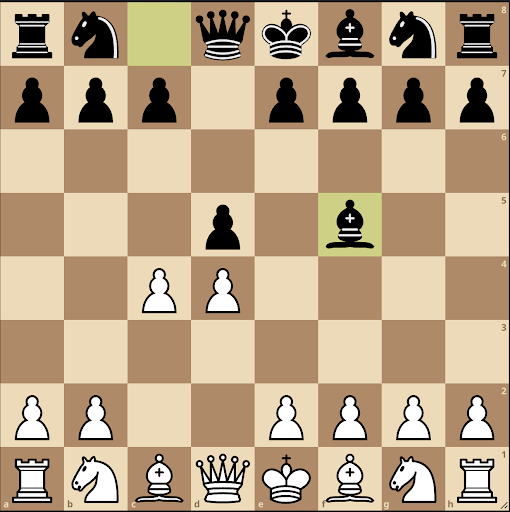Learn Chess. Learn Life Lessons.
Come, join us and transform your kid’s life through chess.
Join Online Coaching Join In-Person Coaching
The Baltic Defense is an offbeat choice for players seeking to surprise their opponents and avoid well-trodden opening theory. It allows Black to unbalance the position and create opportunities for counter attacking play. However, it comes with its own set of risks and challenges.
The Baltic Defense is a relatively obscure chess opening that is characterized by a unique and unconventional pawn structure.
1. d4 d5
2. c4 Bf5

In this opening, Black immediately challenges White’s center by attacking the d4 pawn with the queen. The Baltic Defense is considered a semi-open game since White has made a central pawn move while Black has developed the queen early.
While the Baltic Defense does not have the same level of depth in terms of variations as other chess openings, one of the main continuations for White is:
1. d4 d5
2. c4 Bf5
In this line, Black develops their knight and later their bishop to active squares, putting pressure on White’s e4 pawn. Black’s setup allows for a flexible and dynamic game.

In response to this opening, White has various options, including 3.Nf3, 3.cxd5, 3.Qb3, and 3.Nc3. The game might go on to 3.Nf3 e6; followed by:
The Baltic Defense is known for its flexibility, and various move orders can lead to different types of positions. For example, instead of 4. d4, White might opt for 4. Bf4, 4. g3, or even 4. h3, each leading to unique positions and imbalances.
The Baltic Defense is not without its drawbacks. Some of its disadvantages include:
Early Queen Development: By bringing out the queen early, Black allows White to gain tempi by attacking the queen.
Center Weakness: The early queen sortie can lead to central weaknesses for Black, which White can exploit.
Lack of Development: Black’s opening moves often result in underdeveloped pieces, making it challenging to achieve harmonious development
While the Baltic Defense is not frequently seen at the highest levels of chess, some instructive games showcase the opening’s tactical potential. One notable example is the game between Lev Gutman and Vladimir Bagirov in 1978, which featured sharp tactics and creative play from both sides.
“Modern Chess Openings” by Nick de Firmian and Walter Korn – This comprehensive opening encyclopedia covers a wide range of openings, including the Baltic Defense.
“The Complete Manual of Positional Chess: The Russian Chess School 2.0 – Opening and Middlegame” by Konstantin Sakaev and Konstantin Landa – This book offers insights into various openings, including the Baltic Defense, with a focus on the positional aspects.
“Chess Openings for Black, Explained” by Gary Lane – This book includes explanations of various openings for Black, including the Baltic Defense, and provides practical advice for club players.
The Baltic Defense is considered unconventional and is not a common choice among strong players. While it can lead to imbalanced positions, it comes with risks, and players should be prepared for sharp play.
Yes, the Baltic Defense can be an effective surprise weapon at lower levels of play, where opponents may not be as familiar with its intricacies.
Yes, some openings can transpose into similar pawn structures, such as the Scandinavian Defense (1. e4 d5) and certain lines of the Caro-Kann Defense (1. e4 c6 2. d4 d5 3. exd5 cxd5 4. c4 Qa5+).

This article is technically edited and reviewed by Grand Master Marian Petrov.

CHESS KLUB offers chess classes for kids and adults of all levels. Our coaches include FIDE, National, International and Grand Masters among many.
We offer Online and Classroom coaching.
CHESS KLUB has coaching centers in the US and India now!
Do you want to see your kid excel in Chess?
Learn Chess. Learn Life Lessons.
